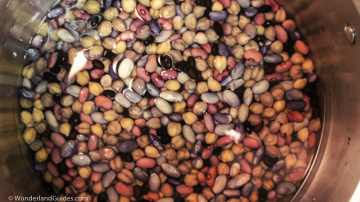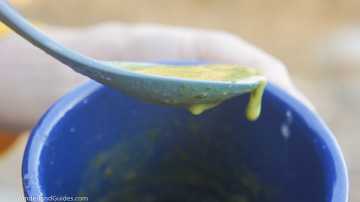>
Backcountry cooking

Backcountry Cooking
Practical meal planning, recipes, and preservation techniques for amazing trail food
DIY lightweight backpacking meals
Lightweight, tasty, and inexpensive meals for backpacking aren't difficult to prepare.
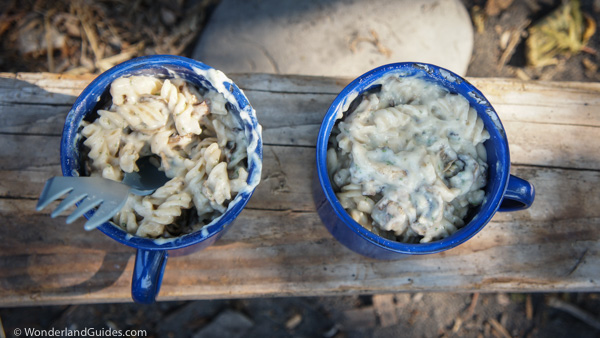 Eating well on the trail doesn't mean a heavy pack. Building a good meal plan system is first about understanding the nutrition your body needs when backpacking, and secondly which ingredients and recipes have proven their worth to long-distance backpackers who take on trails like the PCT and the AT.
Eating well on the trail doesn't mean a heavy pack. Building a good meal plan system is first about understanding the nutrition your body needs when backpacking, and secondly which ingredients and recipes have proven their worth to long-distance backpackers who take on trails like the PCT and the AT.
Food dehydrating 101
Everything you need to know to get started dehydrating fruits, vegetables, meats, sauces and more.
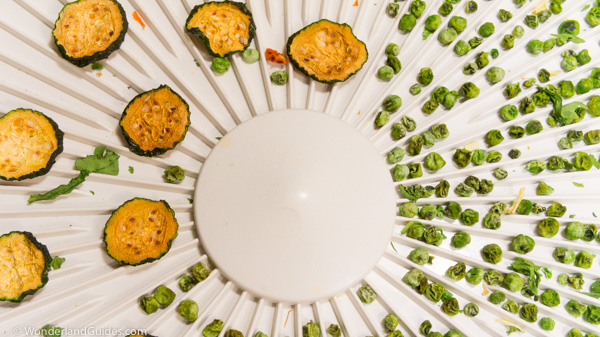 If you're starting out with food dehydrating or want to improve your results, this article is for you. When you understand the science of food dehydration, it's easy to make informed decisions about how to treat different ingredients and get the best results every time. Here we cover the basics that will get you started like a pro.
If you're starting out with food dehydrating or want to improve your results, this article is for you. When you understand the science of food dehydration, it's easy to make informed decisions about how to treat different ingredients and get the best results every time. Here we cover the basics that will get you started like a pro.
Camping & Backpacking Recipes
Lightweight, nutritious and delicious trail-proven recipes
Griddle biscuits with roast plum
 These griddle biscuits are fried rather than baked, and turn out excellent when cooked above a campfire. Roast whatever fruit you have on hand to make a fruit butter topping.
These griddle biscuits are fried rather than baked, and turn out excellent when cooked above a campfire. Roast whatever fruit you have on hand to make a fruit butter topping.
Couscous curry
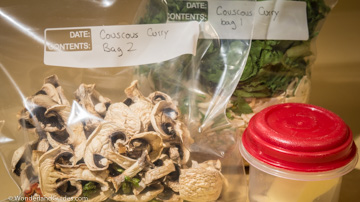 A hearty backpacking favorite, this couscous curry dinner recipe is loaded with mushrooms, carrots, bell pepper, and spinach.
A hearty backpacking favorite, this couscous curry dinner recipe is loaded with mushrooms, carrots, bell pepper, and spinach.
Food dehydrating techniques
Expert techniques for mastering the art and science of food dehydration
Using ascorbic acid as a sulfite alternative to prevent fruit browning
Treating fruit with an ascorbic acid (vitamin C) solution is an effective approach to reducing oxidation and spoilage in fresh fruit. This is commonly employed by caterers who need to deliver sliced fruit with a minimum of browning. It's also a good technique to keep your fruit from partially spoiling during the first few hours in the food dehydrator.
Food dehydrator recipes
Get the best results possible when dehydrating fresh ingredients
Bananas
 Dehydrating bananas yourself gives you the option of a much healthier snack than conventionally dehydrated banana chips. Most commercially produced banana chips are deceptively unhealthy. Here's how I dehydrate my own organic banana chips for hiking snacks. This yields a product that is softer and chewier than conventional banana chips.
Dehydrating bananas yourself gives you the option of a much healthier snack than conventionally dehydrated banana chips. Most commercially produced banana chips are deceptively unhealthy. Here's how I dehydrate my own organic banana chips for hiking snacks. This yields a product that is softer and chewier than conventional banana chips.
Pineapple
 Quality pineapple that has been properly dehydrated stands out as one of the most delicious dried fruits available. It is like candy, chewy and loaded with sugar crystals. It makes a superb snack for hiking and is one of the healthier ways to tame a sweet tooth.
Quality pineapple that has been properly dehydrated stands out as one of the most delicious dried fruits available. It is like candy, chewy and loaded with sugar crystals. It makes a superb snack for hiking and is one of the healthier ways to tame a sweet tooth.
Apples
 Apples dehydrate quickly and easily. Some varieties taste much better dehydrated than others. Slices are best pre-treated with a dip or a blanch before drying to prevent oxidation. They usually take 6-12 hours in most conventional food dehydrators.
Apples dehydrate quickly and easily. Some varieties taste much better dehydrated than others. Slices are best pre-treated with a dip or a blanch before drying to prevent oxidation. They usually take 6-12 hours in most conventional food dehydrators.
Figs
 If you live on the west coast and have the space, you should plant a fig tree. They can be prolific sources of fruit. Though it's important to only dry ripe and delicious figs, when done right, they make an excellent fruit for the trail. Here's my best advice for dehydrating figs the right way.
If you live on the west coast and have the space, you should plant a fig tree. They can be prolific sources of fruit. Though it's important to only dry ripe and delicious figs, when done right, they make an excellent fruit for the trail. Here's my best advice for dehydrating figs the right way.
Apricots
 It's often a better deal to buy conventionally dehydrated apricots unless you are lucky enough to have a tree. Apricots are usually quite easy to dehydrate but should be pretreated to prevent spoilage while they're drying.
It's often a better deal to buy conventionally dehydrated apricots unless you are lucky enough to have a tree. Apricots are usually quite easy to dehydrate but should be pretreated to prevent spoilage while they're drying.
Blueberries
 Blueberries can be a welcome addition to many backcountry breakfasts and snacks. When dried, they pack a lot of flavor for the weight. Here's my technique for drying blueberries, including a quick "check" to speed up dehydration and rehydration.
Blueberries can be a welcome addition to many backcountry breakfasts and snacks. When dried, they pack a lot of flavor for the weight. Here's my technique for drying blueberries, including a quick "check" to speed up dehydration and rehydration.
Cherries
 Dried cherries don't top my list of favorite fruit for backpacking, but they can be a welcome addition to granola and trail mix. If you have a tree or stumble upon a bonanza deal at the fruit stand, it's worthwhile to run a few trays through the dehydrator. Here's how I do it.
Dried cherries don't top my list of favorite fruit for backpacking, but they can be a welcome addition to granola and trail mix. If you have a tree or stumble upon a bonanza deal at the fruit stand, it's worthwhile to run a few trays through the dehydrator. Here's how I do it.
Kiwi Fruit
 Dried kiwi fruit is an awesome ingredient in granola and trail mix. You probably haven't tried dried kiwi fruit because it's not often available in stores. They pack a lot of flavor and can offer some nice variety to the usual dried fruits for backpacking. In California their harvest season runs October through April, so don't wait until the hiking season to dry some.
Dried kiwi fruit is an awesome ingredient in granola and trail mix. You probably haven't tried dried kiwi fruit because it's not often available in stores. They pack a lot of flavor and can offer some nice variety to the usual dried fruits for backpacking. In California their harvest season runs October through April, so don't wait until the hiking season to dry some.
Peaches
 If you're an instant oatmeal fan, you'll appreciate adding some dried peaches. Before dehydrating peaches, you'll need to provide some type of pretreatment. For a sweeter result, you can also dry canned peaches. Here's how I do it.
If you're an instant oatmeal fan, you'll appreciate adding some dried peaches. Before dehydrating peaches, you'll need to provide some type of pretreatment. For a sweeter result, you can also dry canned peaches. Here's how I do it.
Pears
 Dehydrated pears can be enjoyed plain as a simple snack, as sweet highlight ingredients in oatmeal or breads, and also make an interesting addition to savory dishes, pairing beautifully with hard Parmesan, blue, or Romano cheeses.
Dehydrated pears can be enjoyed plain as a simple snack, as sweet highlight ingredients in oatmeal or breads, and also make an interesting addition to savory dishes, pairing beautifully with hard Parmesan, blue, or Romano cheeses.


